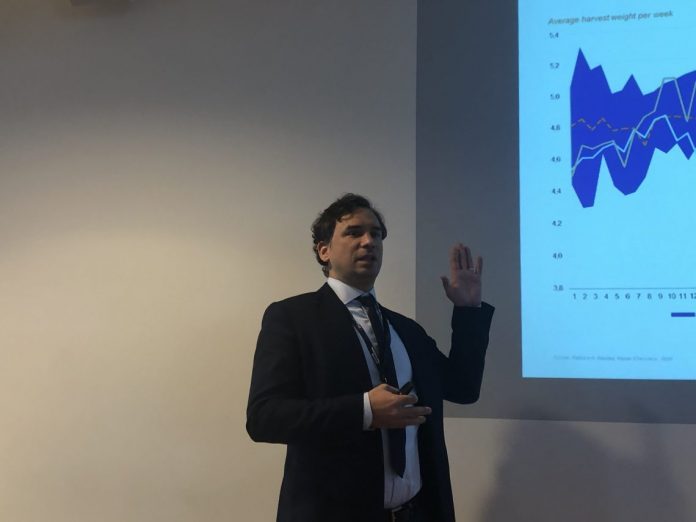Swine fever can have a greater effect than the coronavirus, believes analyst Gorjan Nikolik from Rabobank.
“Our view is that in 2020 we enter a tighter market than we have had before. We’ll see if the coronavirus will have any effect, but our starting point are higher prices.”
Rabobank analyst Gorjan Nikolik tells this during Marel’s annual ShowHow conference, in the company’s premises just outside of Copenhagen, Denmark.
Rabobank multinational operation is exclusively in the feed and food industry and has EUR 623 billion in outstanding capital.
Interesting
Rabobank estimates the global salmon supply growth to be 1.9 pct. in 2020 and 2.8 pct. in 2021.
“This is somewhat lower than the consensus”, says the Dutch analyst who has Macedonian descent.
Nikolik thinks there will be a slightly negative growth in Chile and a marginally positive growth in Norway. He sees the greatest growth, measured in percentage, in other countries, such as Australia and the Faroe Islands. – Iceland is also starting to become interesting, he adds.
His primary concern for Norway is falling harvest weight.
“You have to go back to 2005 to see a lower weight. The reason for this is especially lice and legislation,” he says, pointing to the loss of fish from removing lice and the fact that the country’s farmers are close to the maximum allowable biomass.
“We begin the year in Norway with very little to build on.”
 The opposite direction
The opposite direction
“In Chile we are looking at the opposite development in harvest weight. After the algae losses in 2016, the average weights have increased. Many say they are reaching their limit. It is becoming difficult for them to increase the mass, and they might also face challenges in repeating these harvesting loads. In my models, I assume that Chile will underperform on weight this year.
“On the market side, we believe the demand is great. Of course, it is not possible to foresee the demand. Very little data is available. But as a bank, we have looked upon the numbers we have and analysed the demand,” he says, highlighting, among other things, that the salmon market responds to consumer trends and is strengthened by processing and product innovation.
He particularly underlines the healthy and strong historical demand in the US and Europe as key drivers in the world market.
Lets not exaggerate the situation in China
“I must mention China,” Gorjan Nikolik says before continuing:
“China takes up less than five pct. of the salmon market. Let’s not exaggerate this. The coronavirus has less effect in the salmon industry than in the shrimp market,” he points out.
“Another effect in China is African Swine Fever. It has a much more extensive effect,” says Nikolik, pointing to large losses in the pig population in the country. – 20 million tonnes – that’s ten times the salmon industry – it’s lost. This needs to be covered. Everything from chicken, duck and some seafood will increase in demand. It is guaranteed.
The combination of low supply growth and solid demand should result in increased salmon prices, he predicts.
“The prices are so unstable. The first thing I look at is Fish Pool. This shows that prices are high and will gradually fade. But looking at the end of the line, the long-standing normalized salmon price. It is around NOK 65. We are now at NOK 62 on an annual basis. This is an optimistic sign.”
Most potential in offshore
Land based salmon projects receive a lot of press coverage and attention. But the Rabobank analyst does not expect a flood of salmon from these farms.
“We have probably looked at 30 different projects on land. As a long-term investor, this is not something we can contribute to. We have funded two projects. But many new projects may follow in the next 12 to 24 months,” he says.
“I’m actually more optimistic when it comes to offshore farming.”
Nikolik underlines he believes the most in NRS, Nordlaks and Salmar.

